Gojong of Korea
| Gojong 고종 高宗 | |
|---|---|
| Emperor of Korea | |
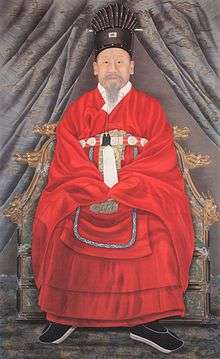 Emperor Gwangmu of Korea | |
| Emperor of Korea | |
| Reign | 1897 — 21 January 1907 |
| Predecessor | Himself as King of Joseon |
| Successor | Sunjong |
| King of Joseon | |
| Reign | 13 December 1863 — 1897 |
| Predecessor | Cheoljong |
| Successor | Kingdom transformed as empire |
| Regent |
Heungseon Daewongun (1863–1873) Queen Min (1873–1895) |
| Born |
8 September 1852 Unhyeon Palace, Hanseong, Joseon Dynasty |
| Died |
21 January 1919 (aged 66) Deoksu Palace, Keijo (Seoul), Japanese Empire |
| Burial | Hongneung |
| Spouse |
Queen Min posthumously known as Empress Myeongseong |
| Issue |
Emperor Sunjong Prince Imperial Ui Crown Prince Euimin Deokhye, Princess of Korea |
| House | House of Yi |
| Father | Heungseon Daewongun |
| Mother | Grand Lady Min Yŏhŭng |
| Korean name | |
| Hangul | 고종 광무제 (short 고종) |
|---|---|
| Hanja | 高宗光武帝 (short 高宗) |
| Revised Romanization | Gojong Gwangmuje (short Gojong) |
| McCune–Reischauer | Kojong Kwangmuje (short Kojong) |
| Birth name | |
| Hangul | 이명복 later 이희 |
| Hanja | 李命福 later 李㷩[1] |
| Revised Romanization | I Myeong-bok later I Hui |
| McCune–Reischauer | Yi Myŏng-bok later Yi Hŭi |
Gojong (Hangul: 고종; Hanja: 高宗; RR: Gojong; MR: Kojong), the Emperor Gwangmu (Hangul: 광무제; Hanja: 光武帝; RR: Gwangmuje; MR: Kwangmuje; 8 September 1852 – 21 January 1919), was the twenty-sixth king and the second-last emperor of the Korean Joseon dynasty.
Reign
King of the Joseon dynasty
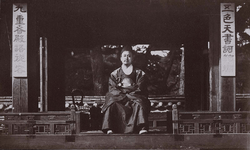
Gojong took the Joseon throne in 1863 when still a child. As a minor, his father, the Heungseon Daewongun (or more commonly, the Daewongun), ruled as regent for him until Gojong reached adulthood.
During the mid-1860s, the Heungseon Daewongun was the main proponent of isolationism and the instrument of the persecution of native and foreign Catholics, a policy that led directly to the French invasion and the United States expedition to Korea in 1871. The early years of the Daewongun's rule also witnessed a concerted effort to restore the largely dilapidated Gyeongbok Palace, the seat of royal authority. During the Daewongun's reign, Joseon factional politics, the Seowon (learned academies that often doubled as epicenters of factional power), and the power wielded by the Andong Kim clan, completely disappeared as political forces within Korean state life.
In 1873, Gojong announced his assumption of direct royal rule. With the retirement of the Heungseon Daewongun, Gojong's consort, Queen Min (posthumously known as Empress Myeongseong), gained complete control over the court, placing her family members in senior court positions.
External Pressures and Unequal Treaties
In the 19th century tensions mounted between Qing China and Japan, culminating in the First Sino-Japanese War in 1894–1895. Much of this war was fought on the Korean peninsula. Japan, after the Meiji Restoration, had acquired Western military technology and had forced Joseon to sign the Treaty of Ganghwa in 1876. Japan encroached upon Korean territory in search of fish, iron ore, and other natural resources. It also established a strong economic presence in the peninsula, heralding the beginning of Japanese Imperial expansion in East Asia.
The French campaign against Korea of 1866, United States expedition to Korea in 1871 and the Incident of the Japanese gunboat Unyo put pressure on many of Joseon's officials, including King Gojong.
The Treaty of Ganghwa became the first unequal treaty signed between Korea and a foreign country; it gave extraterritorial rights to Japanese citizens in Korea and forced the Korean government to open three ports, Busan, Incheon and Wonsan, to Japanese and foreign trade. With the signing of its first unequal treaty, Korea became easy prey for many imperialistic powers, and later the treaty led to Korea being annexed by Japan.[2]
Imo Rebellion and Gapsin Coup
King Gojong began to rely on a new paid army of rifle-equipped soldiers. The old army, which was primarily armed with swords, spears, and old matchlocks, eventually revolted as a result of their mediocre wages and loss of prestige, and the Heungseon Daewongun was restored to power. However Chinese troops led by the Qing Chinese general Yuan Shikai soon abducted the Daewongun and took him to China, thus foiling his return to power. Four years later the Daewongun returned to Korea.
On 4 December 1884, five revolutionaries initiated the Gapsin Coup, an attempted coup d'etat, by leading a small anti-old minister army, attempting to detain King Gojong and Queen Min. The coup failed after 3 days. Some of its leaders, including Kim Okgyun, fled to Japan, and others were executed.
Peasant Revolts
Widespread poverty presented significant challenges to the 19th century Joseon Dynasty. One indication of this poverty was the poor conditions of life suffered by those of the lower classes, who often had little to eat and lived in little more than run down shanties lined along roads of dirt and mud.[3] A number of factors, including famine, poverty, high taxes and corruption among the ruling class, led to several notable peasant revolts in the 19th century. King Gojong's predecessors had suppressed an 1811–1812 revolt in the Pyeongan Province, led by Hong Kyong-nae.[4]
In 1894, another major revolt, the Donghak Peasant Revolution took hold as an anti-government, anti-yangban and anti-foreign campaign. To suppress the rebellion, the Joseon government requested military aid from Japan, thus deepening Japanese claims to Korea as a protectorate.[5] In the end the revolution failed, but many of the peasants' grievances were later dealt with by the Gabo Reform.
Assassination of Queen Min
In 1895, Queen Min was assassinated by Japanese agents. The Japanese minister to Korea, Miura Goro orchestrated the plot against her. A group of Japanese agents entered the Gyeongbokgung in Seoul, which was under guard by Korean troops sympathetic to the Japanese, and the Queen was killed in the palace. The Queen had attempted to counter Japanese interference in Korea and was considering turning to Russia or China for support.
Anti-Japanese Sentiments in Korea
By 1895 Japan had won the Sino-Japanese War, gaining much more influence over the Korean government. The Gabo reforms and the assassination of the Queen also stirred controversy in Korea, fomenting Korean anti-Japanese sentiments.
Some Confucian scholars, as well as farmers, formed over 60 successive righteous armies to fight for Korean freedom. These armies were preceded by the Donghak movement and succeeded by various Korean independence movements.
Korea Royal Refuge at the Russian Legation
On 11 February 1896, King Gojong and his crown prince fled from the Gyeongbokgung to the Russian legation in Seoul, from which they governed for about one year, an event known as Korea royal refuge at the Russian legation.
Proclamation of Empire
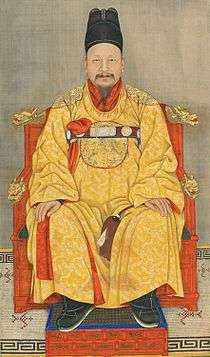
In 1897, King Gojong, yielding to rising pressure from overseas and the demands of the Independence Association-led public opinion, returned to Gyeongungung (modern-day Deoksugung). There he proclaimed the founding of the Empire of Korea, officially redesignated the national title as such, and declared a new era name Gwangmu (Hangul: 광무, Hanja: 光武) (meaning, "shining and martial"). This effectively ended Korea's historic subordination to the Qing Chinese empire which Korea had acknowledged since the fall of the Ming Dynasty, King Gojong took the title of Gwangmu Emperor, and became the first imperial head of state and hereditary sovereign of the Empire of Korea.
This marked the end of the traditional Chinese tributary system in the Far East. Adopting the status of Empire meant that Korea was declaring itself the co-equal of Qing China, that it was independent of it and, at least nominally, it implemented the "full and complete" independence of Korea as recognized in 1895.
Emperor of Korea

Gojong proclaimed the Korean Empire in 1897 to justify the country's ending of its traditional tributary subordination to China. He tried to promote the ultimately unsuccessful Gwangmu Reform.
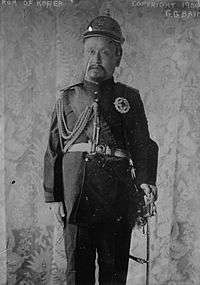
In 1904-5, the Japanese military achieved a comprehensive victory in the Russo-Japanese War. Following the Protectorate Treaty of 1905 between Korea and Japan, which stripped Korea of its rights as an independent nation, Gojong sent representatives to the Hague Peace Convention of 1907 in order to try to re-assert his sovereignty over Korea. Although the Korean representatives were blocked by the Japanese delegates, they did not give up, and later held interviews with newspapers.
One representative warned forebodingly of Japanese ambitions in Asia: "The United States does not realize what Japan's policy in the Far East is and what it portends for the American people. The Japanese adopted a policy that in the end will give her complete control over commerce and industry in the Far East. Japan is bitter against the United States and against Great Britain. If the United States does not watch Japan closely she will force the Americans and the English out of the Far East."
As a result, Gojong was forced to abdicate by the Japanese and Gojong's son Sunjong succeeded to the throne.
After Abdication
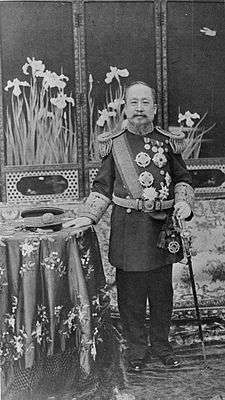
After abdicating, Emperor Gojong was confined to the Deoksu Palace by the Japanese. On 22 August 1910, the Empire of Korea was annexed by Japan under the Japan-Korea Annexation Treaty.
Gojong died suddenly on 21 January 1919 at Deoksugung Palace at the age of 67. There is much speculation that he was killed by poison administered by Japanese officials, an idea that gained wide circulation and acceptance at the time of his death. His death and subsequent funeral proved a catalyst for the March First Movement for Korean independence from Japanese rule. He is buried with his wife at the imperial tomb of Hongneung (홍릉, 洪陵) in the city of Namyangju.
Family
| Joseon dynasty monarchs | ||||||||||||||||||||||||||||||||||||||||||||||||||||||
|---|---|---|---|---|---|---|---|---|---|---|---|---|---|---|---|---|---|---|---|---|---|---|---|---|---|---|---|---|---|---|---|---|---|---|---|---|---|---|---|---|---|---|---|---|---|---|---|---|---|---|---|---|---|---|
|
||||||||||||||||||||||||||||||||||||||||||||||||||||||
- Father: Yi Ha-eung, Heungseon Daewongun (Prince of the Great Court) (흥선대원군)
- Mother: Grand Lady Min Yŏhŭng, Princess Consort to the Prince of the Great Court, of the Yŏhŭng Min clan (여흥부대부인 민씨)
- Consorts and their respective children:
- Empress Myeongseong of the Yeoheung Min clan (명성황후 민씨,[notes 1] 19 October 1851 – 8 October 1895)\
- Unnamed Prince (1871[notes 2])
- Crown Prince of the Empire, (황태자 25 March 1874 – 24 April 1926)
- Unnamed Prince (1875[notes 3])
- Unnamed Prince (1878[notes 4])
- Unnamed Princess (1873[notes 5])
- Honorable Princess Consort of the Eom clan[notes 6][notes 7] (귀비 엄씨, 5 January 1854 – 20 July 1911)
- Crown Prince Euimin (의민태자,[notes 8] 20 October 1897 – 1 May 1970). Gojong's seventh son. He married Princess Masako Nashimotonomiya of Japan, a daughter of Prince Morimasa Nashimotonomiya of Japan.
- Lee Gwi-in of the Yeongbo Hall (영보당귀인 이씨, 1847–1928)
- Prince Wanhwa (완화군,[notes 9] 16 April 1868 – 12 January 1880)
- Unnamed Princess
- Jang Gwi-in (귀인 장씨)
- Prince Euihwa (의화군,[notes 10] 30 March 1877 – August 1955).He married Kim Su-deok (who became Princess Deogin), daughter of Baron Kim Sa-jun.
- Lee Gwi-in[notes 11] of the Gwanghwa Hall (광화당귀인 이씨, 1887–1970)
- Yi Yook, Prince of the Empire (이육, 1914–1915[notes 12])
- Jeong Gwi-in of the Bohyeon Hall (보현당귀인 정씨)
- Yi Woo, Prince of the Empire (이우, 1915–1916)
- Yang Gwi-in of the Boknyeong Hall (복녕당귀인 양씨, 1882–1929)
- Princess Deokhye (덕혜옹주, 25 May 1912 – 11 April 1989). Gojong's 4th daughter. She married Count Takeyuki Sō, a Japanese nobleman of Tsushima.
- Lee Gwi-in of the Naean Hall (내안당귀인 이씨)
- Unnamed Princess
- Lady Kim[notes 13] of the Samchuk Hall (삼축당상궁 김씨, 1890–1972)
- No issue
- Lady Kim of the Jeonghwa Hall (정화당상궁 김씨, 1871–?)
- No issue
- Lady Yeom (상궁 염씨)
- Yi Mun-yong, Princess of the Empire (이문용, 1900–1987)
- Lady Seo (상궁 서씨)
- No issue
- Lady Kim[notes 14] (상궁 김씨)
- No issue
Titles
- The Lord Yi Myeong-bok (Jaehwang) (李命福 이명복 Yi Myeong-bok), second son of Prince Heungseon, a great-great-grandson of Yeongjo (1852–1863)
- His Royal Highness King Gojong of Korea (1863–1894)
- "His Majesty" King Gojong Of Korea (1894-1897)
- His Imperial Majesty Emperor Gwangmu of Korea (大韓帝國光武大皇帝陛下 대한제국광무대황제폐하 Daehan Jeguk Gwangmu Daehwangje Pyeha) (1897–1907)
- His Imperial Majesty The Emperor Emeritus of Korea (大韓帝國太皇帝陛下 대한제국태황제폐하 Daehan Jeguk Taehwangje Pyeha) (1907–1910), after his abdication by force of the Japanese government.
- His Royal Highness The King Emeritus Yi of Korea (德壽宮李太王殿下 덕수궁이태왕전하 Deoksugung Yi Taewang Jeonha) (1910–1919), a demoted title given by the Japanese government on the annexation of Korea, ignored in Korea.
Honours
- Grand Cross of the Order of Saints Maurice and Lazarus of Italy – 1895
- Grand Cross of the Legion d'Honneur of France – 1895
- Collar of the Order of the Chrysanthemum – 1897
- Knight Grand Commander of the Order of the Indian Empire (GCIE) – 1900
- Grand Cross with Collar of the Order of Charles III of Spain – 1900
- Grand Cross of the Order of Leopold of Belgium – 1901
- Collar of the Imperial Order of the Double Dragon, 1st Class, 1st Grade of the Chinese Empire – 1903
- Knight of the Order of St. Stanislaus of the Russian Empire – 1903
- Knight of the Order of the Elephant of Denmark – 1903
- Knight of the Order of the Black Eagle of Prussia – 1904
His Era Name
During the Joseon Dynasty
- Gaeguk (開國, 개국 : used for the reign of King Gojong 1894 – 1895)
- Geonyang (建陽, 건양 : used for the reign of King Gojong 1896 – 1897)
During the Korean Empire
- Gwangmu (광무; 光武; "Bright Valour") – used for the reign of Emperor Gojong, 1897–1907
His Full Posthumous Name
- His Imperial Majesty Emperor Gojong Tongcheon Yung-un Jogeuk Donyun Jeongseong Gwang-ui Myeonggong Daedeok Yojun Sunhwi Umo Tanggyeong Eungmyeong Ripgi Jihwa Sinryeol Oehun Hong-eop Gyegi Seonryeok Geonhaeng Gonjeong Yeong-ui Honghyu Sugang Munheon Mujang Inik Jeonghyo Tae of Korea
- 대한제국고종통천융운조극돈윤정성광의명공대덕요준순휘우모탕경응명립기지화신렬외훈홍업계기선력건행곤정영의홍휴수강문헌무장인익정효태황제폐하
- 大韓帝國高宗統天隆運肇極敦倫正聖光義明功大德堯峻舜徽禹謨湯敬應命立紀至化神烈巍勳洪業啓基宣曆乾行坤定英毅弘休壽康文憲武章仁翼貞孝太皇帝陛下
- Daehan Jeguk Gojong Tongcheon Yung-un Jogeuk Donyun Jeongseong Gwang-ui Myeonggong Daedeok Yojun Sunhwi Umo Tanggyeong Eungmyeong Ripgi Jihwa Sinryeol Oehun Hong-eop Gyegi Seonryeok Geonhaeng Gonjeong Yeong-ui Honghyu Sugang Munheon Mujang Inik Jeonghyo Tae Hwangje Pyeha
Ancestry
| Ancestors of Emperor Gojong | ||||||||||||||||||||||||||||||||||||||||||||||||||||||||||||||||||||||||||||||||||||||||||||||||||||||||||||||||||||||||||||||||||||||||||||||||||||||||||||||||||||||||||||||||||||||||||||||||||||||||||||||||||||||||||||||||||||||||||||||||||||||||||||||||||||||||||||||||||||||||
|---|---|---|---|---|---|---|---|---|---|---|---|---|---|---|---|---|---|---|---|---|---|---|---|---|---|---|---|---|---|---|---|---|---|---|---|---|---|---|---|---|---|---|---|---|---|---|---|---|---|---|---|---|---|---|---|---|---|---|---|---|---|---|---|---|---|---|---|---|---|---|---|---|---|---|---|---|---|---|---|---|---|---|---|---|---|---|---|---|---|---|---|---|---|---|---|---|---|---|---|---|---|---|---|---|---|---|---|---|---|---|---|---|---|---|---|---|---|---|---|---|---|---|---|---|---|---|---|---|---|---|---|---|---|---|---|---|---|---|---|---|---|---|---|---|---|---|---|---|---|---|---|---|---|---|---|---|---|---|---|---|---|---|---|---|---|---|---|---|---|---|---|---|---|---|---|---|---|---|---|---|---|---|---|---|---|---|---|---|---|---|---|---|---|---|---|---|---|---|---|---|---|---|---|---|---|---|---|---|---|---|---|---|---|---|---|---|---|---|---|---|---|---|---|---|---|---|---|---|---|---|---|---|---|---|---|---|---|---|---|---|---|---|---|---|---|---|---|---|---|---|---|---|---|---|---|---|---|---|---|---|---|---|---|---|---|---|---|---|---|---|---|---|---|---|---|---|---|---|---|---|
| ||||||||||||||||||||||||||||||||||||||||||||||||||||||||||||||||||||||||||||||||||||||||||||||||||||||||||||||||||||||||||||||||||||||||||||||||||||||||||||||||||||||||||||||||||||||||||||||||||||||||||||||||||||||||||||||||||||||||||||||||||||||||||||||||||||||||||||||||||||||||
See also
Notes
- ↑ She is given the posthumous title of 태황후 Taehwanghu
- ↑ He only lived for 4 days
- ↑ He only lived for 14 days (about 2 weeks)
- ↑ He only lived for 105 days (about 3 months, 2 weeks, 1 day)
- ↑ She only lived for 222 days (about 7 months, 1 week, 5 days)
- ↑ She is given the posthumous title of 순헌황귀비 (Sunheon Hwang-Gwi-bi "Sunheon, Imperial Concubine of the Highest Rank")
- ↑ Her whole name is Eom Seon-yeong (엄선영), daughter of Eom Jin-sam (엄진삼) and Jeung Chan-jeong (증찬정)
- ↑ During the Korean Empire, he is named "Prince Yeong of the Empire" (영친왕)
- ↑ During the Korean Empire, he is posthumously named as "Prince Wan of the Empire" (완친왕)
- ↑ During the Korean Empire, he is named "Prince Ui of the Empire" (의친왕)
- ↑ Her whole name is Lee Wan-heung (이완흥)
- ↑ Others say that he lived 1906–1908
- ↑ Her whole name is Kim Ok-gi (김옥기)
- ↑ Her whole name is Kim Chung-yeon (김충연)
References
- ↑ 高宗太皇帝行狀
- ↑ Lee Jae-min (8 September 2010). "Treaty as prelude to annexation". The Korea Herald. Retrieved 26 July 2012.
- ↑ Lankov, Andrei; Kim EunHaeng (2007). The Dawn of Modern Korea. 384-12 Seokyo-dong, Mapo-gu, Seoul, South Korea, 121-893: EunHaeng Namu. p. 47. ISBN 978-89-5660-214-1.
- ↑ "Hong Kyŏng-nae Rebellion". Encyclopædia Britannica Online. Encyclopædia Britannica. 2010.
- ↑ Kim Hyungyoon, "Jangheung, Where Korean Literature Is Deeply Rooted"
- ↑ Royal Ark
External links
| Wikimedia Commons has media related to Gojong of the Korean Empire. |
| Gojong of Korea Born: 25 July 1852 Died: 21 January 1919 | ||
| Regnal titles | ||
|---|---|---|
| Preceded by Cheoljong |
King of Joseon 13 December 1863 — 1897 with Heungseon Daewongun (1863–1873) Queen Min (1873–1895) |
Succeeded by Himself as Emperor of Korea |
| Preceded by Himself as King of Korea |
Emperor of Korea 1897 — 21 January 1907 |
Succeeded by Yunghui Emperor |